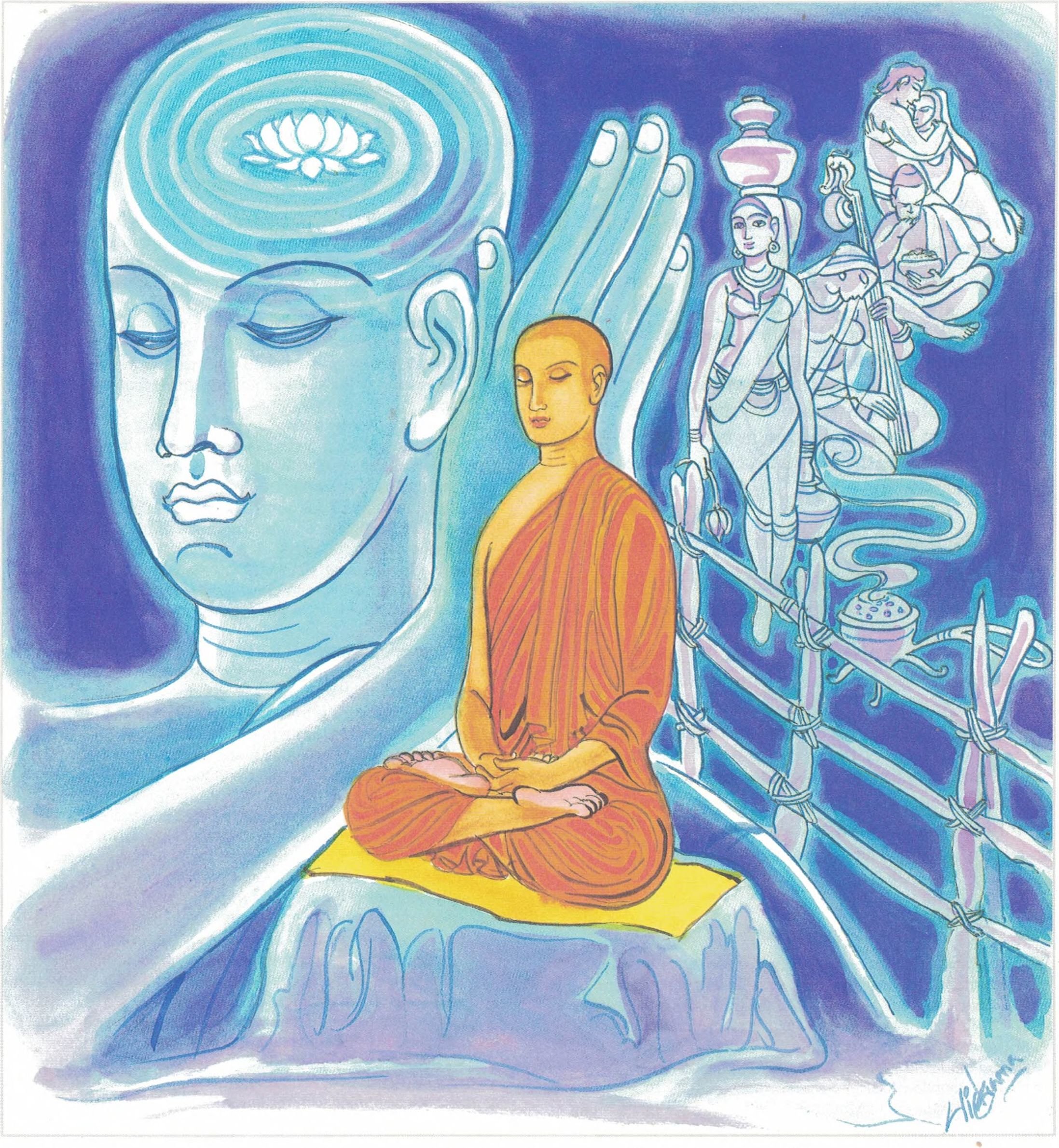Dhammapada (Illustrated)
by Ven. Weagoda Sarada Maha Thero | 1993 | 341,201 words | ISBN-10: 9810049382 | ISBN-13: 9789810049386
This page describes The Story of Mara which is verse 385 of the English translation of the Dhammapada which forms a part of the Sutta Pitaka of the Buddhist canon of literature. Presenting the fundamental basics of the Buddhist way of life, the Dhammapada is a collection of 423 stanzas. This verse 385 is part of the Brāhmaṇa Vagga (The Brāhmaṇa) and the moral of the story is “For whom a far or near exist not, with no anguish or entanglement, him a true brahmin I call”.
Verse 385 - The Story of Māra
Pali text, illustration and English translation of Dhammapada verse 385:
yassa pāraṃ apāraṃ vā pārāpāraṃ na vijjati |
vītaddaraṃ visaṃyuttaṃ tamahaṃ brūmi brāhmaṇaṃ || 385 ||
385. For whom is found no near or far, for whom’s no near and far, free of fear and fetter-free, that one I call a Brahmin True.
 For whom a far or near exist not, with no anguish or entanglement, him a true brahmin I call. |
The Story of Māra
While residing at the Jetavana Monastery, the Buddha spoke this verse with reference to Māra.
On one occasion, Māra came to the Buddha disguised as a man and asked him, “Venerable! You often say the word pāraṃ; what is the meaning of that word?” The Buddha, knowing that it was Māra who was asking that question, chided him, “O’ wicked Māra! The words pāraṃ and apāraṃ have nothing to do with you. Pāraṃ, which means the other shore, can be reached only by the arahats who are free from moral defilements.”
Explanatory Translation (Verse 385)
yassa pāraṃ apāraṃ vā pārāpāraṃ na vijjati
vītaddaraṃ visaṃyuttaṃ taṃ ahaṃ brūmi brāhmaṇaṃ
Yassa: for whom; pāraṃ [pāra]: the farther shore; apāraṃ [apāra]: the near shore; pārāpāraṃ [pārāpāra]: hither and thither shores; na vijjati: do not exist; vītaddaraṃ [vītaddara]: blemishless; visaṃyuttaṃ [visaṃyutta]: free of all defilements; taṃ: that saint; ahaṃ: I; brūmi brāhmaṇaṃ [brāhmaṇa]: describe as a Brāhmaṇa
To him there is no further shore. To him there is no near shore either. To him both these shores are nonexistent. He is free of anxiety and is freed from bonds. That person I describe as a Brāhmaṇa.
Commentary and exegetical material (Verse 385)
pāraṃ: sense fields. Sense fields are twelve, six of which are personal sense-fields, the other six are external sense-fields. These are described as āyatanas–spheres, which is a name for the four immaterial absorptions. The twelve bases or sources on which depend the mental processes, consist of five physical sense-organs and consciousness, being the six personal (ajjhattika) bases; and six objects, the so-called external (bāhira) bases:
eye, or visual organ; visible object,
ear, or auditory organ; sound, or audible object,
nose, or olfactory organ; odour, or olfactive object,
tongue, or gustatory organ; taste, or gustative object,
body, or tactile organ; body-impression, or tactile object,
mind-base, or consciousness; mind-object (manayatana) (dhammāyatana),
By the visual organ (cakkhāyatana) is meant the sensitive part of the eye (cakkhu-pasāda) built up of the four elements… responding to sense-stimuli (sa-ppaṭigha). Similar is the explanation of the four remaining physical sense-organs.
The mind-base (manāyatana) is a collective term for all consciousness, whatever, and should therefore not be confounded with the mind-element (mano-dhātu), which latter performs only the functions of adverting (vajjana) to the sense-object, and of receiving (sampaṭicchana) the sense-object. On the functions of the mind (viññāna-kicca):
The visible object (rūpāyatana) is described as that phenomenon which is built up of the four physical elements and appears as colours. What is seen by visual perception, let’s say eye-consciousness (cakkhu-viññāna), are colours and differences of light, but not three dimensional bodily things.
Mind-object-base (dhammāyatana) is identical with mind-object-element (dhamma-dhātu and dhammārammaṇa). It may be physical or mental, past present or future, real or imaginary.
The five physical sense organs are also called faculties (indriya), and of these faculties it is said: Each of the five faculties owns a different sphere, and none of them partakes of the sphere of another one…; they have mind as their support… are conditioned by vitality… but vitality again is conditioned by heat… heat again by vitality, just as the light and flame of a burning lamp are mutually conditioned.
